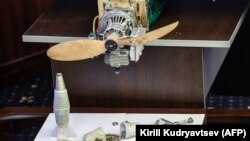On the night of January 5, a swarm of weaponized Unmanned Aerial Vehicles (UAVs) attacked the Russian Air Force base in Khmeimim, Syria. Some reports said rockets had also been fired at the base. On January 8, the Russian Defense Ministry publicly acknowledged the UAV attack, claiming that its anti-aircraft shot down several of the drones while others were captured using electronic warfare systems.
The Defense Ministry’s post includes photographs of the downed UAVs, which resemble model airplanes with what appear to have light mortar rounds attached to their wings. According to the ministry and independent observers, these drones have GPS guidance and the ability to drop their payload once they reach predetermined coordinates. The ministry also claims that there was no damage as a result of the attack.
The Defense Ministry’s post on the attack implies that the rebels who launched the drones must have obtained help from a country which possesses sophisticated technology. Similar implications can be drawn from comments made by the head of the Russian military’s drone division, Major General Alexander Novikov, as well as by Russian President Vladimir Putin in a televised meeting with Russian newspaper editors.
Russian state media also published a claim by a Defense Ministry official who said that forces based at Khmeimim had detected a U.S. Poseidon reconnaissance aircraft in the vicinity of the two bases around the time of the attack. The Pentagon denied the claim.
Despite Russian insistence that the drones are too sophisticated for rebel groups to manufacture without foreign help, several investigations have found that the components are readily available to rebel groups via the black market. A report by the open source intelligence group Bellingcat stated in its summary:
“The Russian MoD claim that whoever launched these drones required nation-state support is dubious. The suggestion that a United States Poseidon aircraft is somehow related to these drones is even more so. The materials and construction of these drones, including their munitions, could all be sourced using relatively local means. No component is particularly advanced, except for the GPS antenna which is fairly standard in most commercial off-the-shelf (COTS) drones anyway.” Bellingcat noted drones of the same design have been seen elsewhere in Syria, “although nothing on the scale of the reported attack at Khmeimim airbase.”
An investigation by The Daily Beast found a channel on the messenger app Telegram which has been used by rebels as a sort of online black market for weapons and equipment. On the channel was an advertisement for two drones of a very similar make to those displayed by the Russian Defense Ministry. This suggests that whoever carried out the attack on the Khmeimim and Tartus bases could have bought the drones online.
While Russian officials did not openly blame the attack on the U.S., the aforementioned Maj. General Novikov later claimed that there was a Ukrainian connection to the drone attack. According to him, the explosives carried in the drones’ payloads contained PETN manufactured at the Shostka Chemical Reagents Plant in Ukraine. In fact, PETN (pentaerythritol tetranitrate) is an extremely common military and commercial explosive manufactured worldwide. An investigation into the claim by the Ukraine anti-propaganda organization StopFake found that the factory in question does not even manufacture explosives and does not possess the means to produce PETN.





